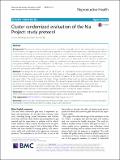Cluster Randomized Evaluation of the Nia Project: Study Protocol
View/
Publication Date
2018-12-19Type
Article, Journalviews
downloads
Metadata
Show full item recordCitation
Muthengi, E., Austrian, K. Cluster randomized evaluation of the Nia Project: study protocol. Reprod Health 15, 218 (2018). https://doi.org/10.1186/s12978-018-0586-4
Abstract/
Background: The onset of puberty and menarche is a specifically vulnerable time for girls, during which they begin to show interest in the opposite sex, while becoming exposed to a myriad of external pressures, including sexual coercion or harassment from boys and men, expectations to marry from their families, and the need to perform well in primary school in order to qualify for secondary school. According to several qualitative studies in Africa, such pressures are exacerbated by girls' lack of knowledge of their bodies, their rights, and the implications of their decisions, and by their inability to manage puberty and adolescence safely and comfortably with appropriate menstrual health and hygiene management (MHM) products. The evaluation of the Nia Project is one of the first to analyze the individual and combined contributions of sanitary pads and provision of comprehensive reproductive health education on girls' education and reproductive health outcomes. Methods: The design for the evaluation of the Nia Project is a longitudinal, cluster-randomized controlled trial consisting of a baseline survey with a cohort of Class 7 girls, a school quality survey, qualitative data collection, school attendance tracking, and an endline survey at the completion of the 18-month intervention period with the same cohort. The study involves 140 public primary schools in three rural sub-counties (Magarini, Kaloleni and Ganze) of Kilifi County in the Coastal area of Kenya. The research sample includes 3489 girls, with about 25 girls per school on average. Before program implementation, the schools were stratified by sub-county and randomized to one of four study arms (35 schools per arm): 1) control, 2) disposable sanitary pads distribution, 2) reproductive health education, and 4) sanitary pad distribution and reproductive health education. Discussion: The evidence provided will inform program investment and design, and contribute to the literature on the effect of menstrual health-based interventions on girls' agency, safety and life outcomes. Trial registration: ISRCTN10894523 . Trial Registration Date: August 22, 2017
Subject/
Adolescent girls; Comprehensive sexuality education; Education; Kenya; Menstrual health; Menstrual hygiene; Randomized trial; Reproductive health; Sanitary pads; School attendance
Further Details
© The Author(s). 2018 Open Access This article is distributed under the terms of the Creative Commons Attribution 4.0 International License (http://creativecommons.org/licenses/by/4.0/), which permits unrestricted use, distribution, and reproduction in any medium, provided you give appropriate credit to the original author(s) and the source, provide a link to the Creative Commons license, and indicate if changes were made. The Creative Commons Public Domain Dedication waiver (http://creativecommons.org/publicdomain/zero/1.0/) applies to the data made available in this article, unless otherwise stated.
Publisher
CrossMarkCollections
- General - GEN [367]

